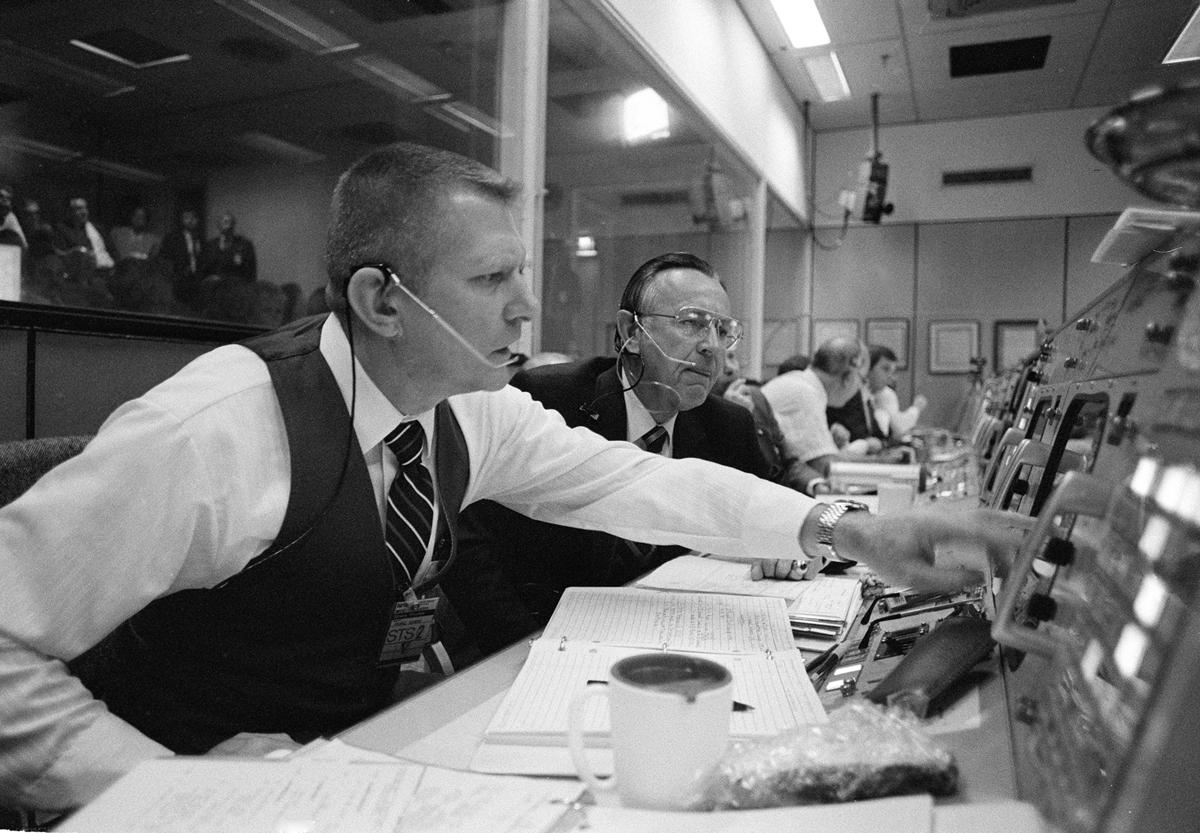Failure Is (and Should Be) An Option

My husband (and the Porch’s Master of Communication), Rob, and I recently started watching the series “For All Mankind” on Apple+. If you haven’t watched it, I will try my best to not reveal any big spoilers…
The premise of the show is an alternative timeline and outcome to the United States and NASA’s “space race”; one where the Russians end up being the first to land on the moon. The show is an exciting exploration into one of America’s, and really the world’s, most historically-significant scientific events of the 20th century…but where Neil, Buzz, and Michael were SECOND to plant their feet, their flag, and their influence in the narrative of space exploration beyond our planet.
There are many of the same figures at NASA and in government (save a few pivots) in the series. One of them is famed Chief Flight Director, Gene Kranz. As a key leader at Johnson Space Center’s Mission Control, Kranz oversaw and led many of the first Gemini and Apollo missions.

Gene Kranz, left, and Christopher Kraft Jr. formed a strong team. NASA
One of the phrases Kranz is famously associated with is: “Failure is not an option”. While he didn’t actually make this statement in real life (Ed Harris, who played him in the movie, Apollo 13, did), he adopted it as his motto and the title of his biography.
While this mindset may be critical in an environment and situation where people’s lives are at stake - like they were during the ill-fated Apollo 13 mission - this principle directive has been adopted by business leaders across many industries when challenged with an obstacle to overcome or a problem to solve. This, in my opinion, is ill-advised, short-sighted, and extremely problematic.
When failure is not an option, this can often lead to solutions that are “safe”, simple… and small. When people are told they are not allowed to fail, creative problem solving and bold, courageous innovation and change are stifled.

Some of the ways this ‘fear of failure’ can manifest include statements such as:
“We need to put [x change] in place, but...
- it can’t impact or slow down our current business”
- we can’t pull people away from their day job”
- we can only spare [certain leaders or subject matter experts] for [x amount per week
- we don’t want to change what or how we’re doing it”
- we can’t hire/dedicate anyone (or anyone else) to this project”
- we can’t spend a lot of time on preparation or discovery…we just need to get this live”
- we don’t have time for a lot of training; our people will just need to deal with it and figure it out.”
- we’re already delayed or behind, we can’t afford to spend any more time on [x]”
- they [the team] are all adults/professionals/experts, they can figure out how to work together on this”
- we don’t have the time or resources for [x]. Our [vendor, consultant, other] can own and solve this.”
When failure (or even a short-term sacrifice) is something to be avoided at all costs, and where the threat of ‘all or nothing’ is hovering like a dark cloud over your teams and organization, change will always be something you “tried, but it didn’t seem to work for us…”
This “failure is not an option” mantra and messaging is a symptom of what’s referred to as a Fixed Mindset. Coined by psychologist and Stanford professor, Carol Dweck, a Fixed mindset is focused on being “right” over exploring what could be the right course of action or what the reality of the situation requires in order to move forward; spotting, inspecting, adjusting, and re-trying as you go. This mindset includes statements or beliefs such as:
- “If it ain’t broke, don’t fix it”
- “I/We don’t have time to discuss this”
- “It is what it is” (as it relates to being open to considering other options)
- “This is how we’ve always done it”
- “I/We/They already know everything needed to proceed”
- “You should already know how to do [x]”
- “If you don’t know [x] by now, it’s too late to show or train you”
- “[X] isn’t professional”
- “We’ll just pay them more (or give them a bonus), and then they’ll do [x]”
- “This must be completed by [x date], regardless of where we’re at”
- “We can’t afford to spend the [time, money, resources] on [x]”
- “I/We don’t want to look stupid or ask for help.”
- "I/We must know the right answer"
The irony here is that, in order to actually avoid failure, you need to create scenarios that introduce failure. It’s through this practicing of what could go wrong that you’re able to better avoid missteps, pitfalls, delays, errors, and a literal or figurative crash.
The Apollo astronauts didn’t just show up on launch day, ready to execute. They spent months, and sometimes even years, training for their mission. Long before they launched, they were learning how to navigate when uncertainties, errors, or failure present themselves. They practiced how to remain present and not let the stress or urgency of the moment impact their ability to think clearly and stay in control. They spent countless hours understanding how to communicate with one another and Mission Control. They learned how to use the tools, principles, practices, and equipment that are vital for a successful team mission. They trained for what could go wrong and understood what was necessary in order to spot, troubleshoot, and solve errors as a team. They focused on how to spot issues before they became critical. They worked together to build trust and accountability with one another. They learned how to communicate to ensure all crew members (and support teams) were aligned. They practiced how to remain cool and clear-minded during high stress and uncertainty.
Bottom line: They prepared for the emotional, physical, and mental demands that were being asked of them.
Kranz referred to this collaboration of smart young minds as the “human factor”. Those men and women who, through dedication, a clear mission and objectives, willpower (and a lot of preparation, practice, creativity, and cool-headedness) had “the right stuff” to innovate, problem-solve under intense pressure, and execute each mission. To Kranz, “They were people who were energized by a mission. And these teams were capable of moving right on and doing anything America asked them to do in space.”
A Fixed mindset will never spot, consider, or implement opportunities for change, choosing certainty and what is already known for something new, untried, and innovative. Some ways to challenge a Fixed Mindset include practicing a few Growth Mindset principles, including:
- “What haven’t I/we considered?”
- “How true is [x]?”
- “What don’t I/we yet know?”
- “What could go wrong here?”
- “Where have we stumbled/struggled in the past?”
- “What have we learned from past stumbles/struggles/failures?”
- “Am I/Are we ready for [x]?”
- “What does failure look like?”
- “What is/are our measure(s) of success?”
- “Do I/we have what we need to proceed?”
- “Do I/we feel prepared?”
In an ironic twist in the “For All Mankind” series, it was their failure of NOT being the first to the moon that ignited NASA’s (and therefore, the United States’) competitive instincts and innovative actions. Their focus to do more than was originally planned was insatiable. It fueled them. The progress that was made was because of, rather than in spite of, them coming in second. It was this “failure” that resulted in HUGE innovations and progress that even today, have not yet been fully realized. This includes the:
- First woman on the moon (1969 vs. still waiting for this one…)
- Creation of a lunar base (1973 vs. nope, still not there…)
- Electric vehicles with a 60-mile range commercially available (1983 vs. dabbled in the mid-1990s, then around 2010)
- First Human on Mars (1995 vs. Check with Elon on the latest there…maybe 2040??)
The interesting thing here is that NASA had greater ambitions and visions beyond landing on the moon. I suspect many of the missions and milestones presented in “For All Mankind” were based on conversations with current and former NASA personnel about where they wanted to take the program. But, those who fund NASA’s innovation (aka, the US government) put a kibosh on those aspirations by drastically reducing their funding, thereby shutting down any future innovation and missions. The real-life Apollo program only lasted from 1963 to 1975. The last moon landing took place in 1972. Apollo 17 was the last mission to land on the moon (vs. still going strong with Apollo 75 in 1983 in the series).
See, it was the winning in real life that caused innovation to stop. They already met their goal. They were first on the moon. They beat the Russians. What’s more to do? We did it first. We didn’t fail. There’s no reason to keep innovating. We “won”.
While we tend to view innovative ideas and leaders as uncommon and very lucky unicorns, the reality is that those moonshot moments were created after a lot of preparation, practice, creative and courageous problem-solving…and failure. In order to innovate, you have to be willing, ready, and prepared to fail.
As Zig Ziglar famously said, "Failure is a detour, not a dead-end street." And it's often that, along those detours, new opportunities are discovered and new routes are mapped and explored.
Failure is (and should) be an option.
Are you prepared to accept failure and use it as fuel to change and grow?
In what ways are you perpetuating the “already won” mindset?
What change opportunities have or are you overlooking because “things aren’t broken, why fix them”?
Where and how are you communicating to your team, your organization, your staffing industry partners and providers that “failure is not an option”?
What questions have or will you begin to ask to challenge fixed mindset, "no-fail" thinking?

